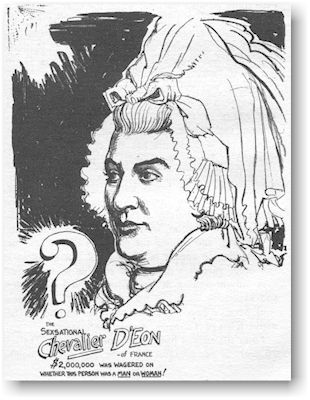
The Dragoon in Drag
(From Ripley's "Believe It or Not" Book of the Military)
Charles d'Eon de Beaumont was born in Burgundy in 1728. He had one of the most controversial careers of all time. In an age when the governor of New York State went around in women's clothes and had his official portrait painted with himself dressed as a fine lady, even the Chevalier d'Eon caused talk.
As an officer of dragoons and aide-de-camp to Marshal Broglie, Charles risked his life at the Battle of Hoxten to rescue 400,000 cartridges that were under enemy fire. But was he a man - or was she a woman?
Chevalier d'Eon had been involved with diplomacy at the court of the Czarina Elizabeth on behalf of Louis XV. Having spent most of his life in England, he (or she) was in London in 1762, negotiating a part of the Peace of Paris. By 1771, bets began to be made about the chevalier's sex. Princess Dashkov from St. Petersburg pointed out that when the chevalier was in Russia, he was in long skirts. That was the way the Russian empress remembered him. Small (five feet four inches) and somewhat effeminate (some Englishmen said, "he's just French"), he did have a black beard. But was it real? Or was he a bearded lady?
Some 300,000 pounds (an incredible sum in those days) was wagered in England alone on the chevalier's sex. The Court of the King's Bench tried cases about whether the wagers had to be paid off and who was to win; but it could not ask the chevalier (who had returned to France ' in a dress) to provide proof one way or the other.
In France, King Louis issued this official order: "Charles Genevieve Louise Augusta Timothee d'Eon de Beaumont is hereby commanded to lay aside the uniform of a dragoon, which he had been in the habit of affecting, and resume the garments of her sex; and is forbidden to appear in any part of our kingdom in any other garments than those suitable to a female."
A lady-in-waiting at Versailles planned a complete aiid expensive wardrobe for the new lady of fashion. And Mlle. d'Eon moved in with her mother in her native town of Tonnerre, a quiet backwater.
Later she moved back to England, spending the last 26 years of her eventful life there. She put on fencing matches before the prince of Wales, but she fenced in petticoats. Wounded in one match, she retired in August 1796.
On May 22, 1810, the little old lady known to all London, on whose sex so much money had been wagered, passed on.
At that time, "the nice problem for history" (as Voltaire put it) was finally and unequivocally solved. The physical evidence proved the dragoon had been in drag; the Chevalier d'Eon was a man!
More historical confusion about sex can be found in the strange case of Thomas/Thomasina Hall.